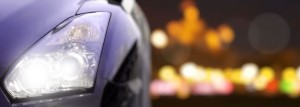What are dipped headlights?
Within a cars headlight units are various types of bulbs. From these various light bulbs are the main beam, also known as full beam or high beam, and the other is the dipped lights or also known as low beam. Other types of bulbs contained within the headlight unit may be sidelights and indicators.
Some models of car headlight units contain a single main and dipped beam bulb that utilises two filaments (dual-filament), whilst other models contain two separate bulbs.
Although it is legal to drive with only sidelights illuminated under certain circumstances at night, dipped headlights provide drivers with a better level of visibility at night and also allows greater visibility for others to see you than that provided by sidelights. Dipped headlights differ from main beam headlights in that they are designed so to cause as little light glare to oncoming vehicles as possible.
In countries that drive on the left such as the UK, dipped headlights are angled lower towards the road and to the left to reduce glare to oncoming traffic, the opposite applies for countries that drive on the right. Dipped and main beam headlight bulbs have a similar if not identical luminosity.
If dipped headlights were not shielded or angled away from oncoming vehicles, the glare produced for oncoming drivers will cause significant discomfort to the eyes and make the road almost impossible to see.

When to use dipped headlights
Driving between sunset and sunrise requires the legal use of sidelights if driving on a road with a speed limit of 30mph or less and has street lighting where lamps are placed at 185 feet (56 metres) or less. Must motorists however tend to prefer the use of dipped headlights due to improved visibility. Other than driving during the hours of darkness, dipped headlights can also be used during daylight hours where visibility is reduced due to heavy rain, snow or fog.
Main beam headlights are angled so to illuminate as much of the road directly ahead as is possible. They also cause significant dazzle to oncoming motorists. As a result drivers must switch from main beam to dipped as soon as an oncoming vehicle it spotted. Whilst following a vehicle, dipped headlights must only be used as main beam will cause dazzle in the mirrors or the vehicles following in front.
Upon overtaking a vehicle, do not activate the main beam until parallel with the vehicle you intend on overtaking, or the last vehicle if overtaking multiple vehicles to avoid mirror dazzle. Driving at night takes practice and experience to perfect. The majority of learner drivers will have had very little or no experience with driving at night. See driving at night for tips and safety precautions.
MOT and dipped headlights
An annual vehicle MOT can easily be failed due to faulty lights and blown bulbs. To keep MOT costs to a minimum, ensure all external vehicle lights are in working order. incorrect headlight alignment can also fail an MOT although in most cases, a vehicle technician is necessary for rectifying such faults.
Dipped headlights law and penalties
All of a vehicles external factory fitted lighting should be in good working condition for the car to remain road worthy. Driving with a faulty headlight that affects the dipped lighting may result in being stopped by the police.
From a simple blown bulb, the police may issue a verbal warning, or possibly a Fixed Penalty Notice (FPN), either an endorsable FPN incurring three penalty points and £60 fine, or a non-endorsable FPN resulting in no penalty points and £30 fine. A Roadside Prohibition Notice may also be issued providing you with 10 days’ notice to get the defect fixed along with proof obtained by a qualified engineer to be given to a police officer at a station.
RELATED Guides on the use of Car Lights
- See car lights law for other guides on how and when to use specific lights on your vehicle
